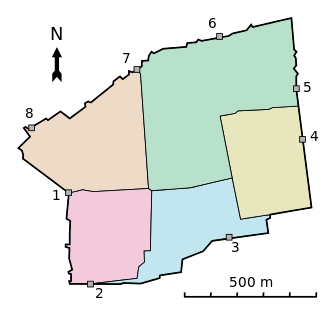Four Sephardic Synagogues
The Four Sephardic Synagogues are located in the Jewish Quarter of the Old City of Jerusalem. They form a complex which comprises four adjoining synagogues which were built at different periods to accommodate the religious needs of the Sephardic community, each congregation practising a different rite. Today, most of them are in active use.
History
With the closing of the Ramban Synagogue at the command of the Ottoman sultan in 1589, there ceased to be a Jewish house of prayer in Jerusalem and the Jews, many of whom were descendants of immigrants who had arrived after the expulsion from Spain in 1492, were forced to pray privately in their own homes. At the beginning of the 17th century a new synagogue, the Yochanan ben Zakai Synagogue, was inaugurated.
In 1835 Muhammad Ali, viceroy of Egypt who ruled Jerusalem at the time, permitted the refurbishment of the synagogues which had been denied since their construction. At the entrance to the Istanbuli Synagogue is a plaque commemorating the restoration.
After the fall of the Jewish Quarter during the 1948 Arab-Israeli War the synagogues were damaged by shell fire. After the Six Day War the synagogues were restored by architect Dan Tanai.
 Yochanan ben Zakai Synagogue
Yochanan ben Zakai Synagogue


According to legend, the Yochanan ben Zakai Synagogue, (Hebrew: בית הכנסת יוחנן בן זכאי), also known as Kahal Kadosh Gadol, stands on the spot of the Beit Midrash of the tanna Rabban Yochanan ben Zakai, who established the Sanhedrin in Yavneh after the destruction of the Second Temple. The current building was constructed at the beginning of the 17th century.
A piece of land below street level was chosen for the synagogue in order to conceal the building from the authorities. Meir Ben Dov, however, is of the opinion that the sub-street level plot wasn’t intentionally chosen, but rather that street level itself was lower at the time and the synagogue had protruded above the street. With time the dwellings surrounding the synagogue were demolished and new houses were built above them, while the synagogue itself was preserved. This cycle continued until today, resulting in the synagogue being situated below street level. It should nevertheless be noted that if construction was indeed permitted, the building itself had to comply with Muslim restrictions for dhimmi houses of prayer not to be higher than mosques.[1] Located in the old Jewish Quarter of Jerusalem, it suffered the same fate as most the synagogues in the area during the 19 year Jordanian occupation after 1948. It has been fully refurbished since Israel gained control of the Old City during the Six Day War. This work was initiated by Rabbi Meir Yehuda Getz, Rabbi of the Western Wall, who also restored the Yeshivat haMekubalim to its former glory.
 Istanbuli Synagogue
Istanbuli Synagogue

As the Sephardi community of Jerusalem grew, a large group of immigrants arrived from Istanbul, Turkey, who used the adjacent building as a synagogue from 1764. Over time, the Istanbuli Synagogue, (Hebrew: בית הכנסת האיסטנבולי), attracted worshipers from the Eastern communities, including Kurdistan and from North and West Africa.
The Hekhal dates from the seventeenth century and was imported from a synagogue which had been destroyed in Ancona, Italy. The Teba, constructed in the eighteenth century, came from a synagogue in Pesaro, Italy. The synagogue was renovated in 1836.
During the Israel War of Independence the synagogue was occupied by Arabs. After Israel gained control of the Old City during the Six Day War, it was renovated.
As the Istanbuli synagogue is the largest of the four, it is used for the inauguration of the Sephardic Chief Rabbi of Israel.
Today, the Istanbuli Synagogue is used by a Spanish and Portuguese congregation following mostly the London rite.
 Eliahu Ha'navi Synagogue
Eliahu Ha'navi Synagogue
.jpg)
Another synagogue was established in the 16th century and named after Elijah the Prophet. This synagogue is the oldest of the four. The Eliyahu Ha'navi Synagogue mainly served as a beth midrash for Torah study. Also known as Kahal Talmud Torah, it was only used for prayer on festivals. According to legend, the name of the synagogue was given after an event that took place on Yom Kippur, when one person was missing to complete the minyan required for prayer. Out of the blue, a man, unknown to the worshippers, appeared and the service was able to start. The man mysteriously disappeared after the Neilah prayer. The people were sure that the man was none other than Elijah the Prophet.
 Emtsai Synagogue
Emtsai Synagogue

The Emtsai Synagogue or Middle Synagogue, (Hebrew: בית הכנסת האמצעי), also known as the Kahal Tzion Synagogue, forms the central chamber of the complex. It was originally a courtyard which was probably used as the women’s section of the Rabban Yohanan Ben Zakai synagogue. During Sukkot it could be converted into a sukkah for the worshippers. With the growth of the community, it was decided during the middle of the 18th century to roof the yard. It was turned into what is today known as the Middle Synagogue, due to its location in the "middle" of the other three synagogues.
References
| Wikimedia Commons has media related to Istanbuli Synagogue. |
External links
- "The Sephardic Council of Jerusalem on the Four Synagogues"
- (in Hebrew) Batei HaKnesset HaSephardim B'Yerushalayim
- (in Hebrew) Arba'at Batei HaKnesset HaSephardim B'Rova HaYehudi
- The Spanish & Portuguese Congregation in Israel (Congregation Sha'are Ratzon)
Coordinates: 31°46′28.11″N 35°13′53.95″E / 31.7744750°N 35.2316528°E
